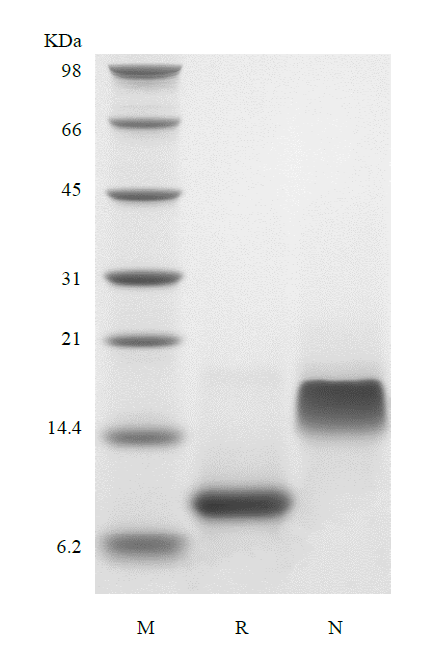- Synonyms
- hSDF-1 beta, IRH, hIRH, PBSF
- Source
- Escherichia coli.
- Molecular Weight
- Approximately 8.5 kDa, a single non-glycosylated polypeptide chain containing 72 amino acid residues.
- AA Sequence
- KPVSLSYRCP CRFFESHVAR ANVKHLKILN TPNCALQIVA RLKNNNRQVC IDPKLKWIQE YLEKALNKRF KM
- Purity
- > 97 % by SDS-PAGE and HPLC analyses.
- Biological Activity
- Fully biologically active when compared to standard. The biological activity determined by a chemotaxis bioassay using PHA and rHuIL-2 activated human peripheral blood T-lymphocytes is in a concentration range of 20-80 ng/ml.
- Physical Appearance
- Sterile Filtered White lyophilized (freeze-dried) powder.
- Formulation
- Lyophilized from a 0.2 µm filtered concentrated solution in PBS, pH 7.4.
- Endotoxin
- Less than 1 EU/μg of rHuSDF-1β/CXCL12β as determined by LAL method.
- Reconstitution
- We recommend that this vial be briefly centrifuged prior to opening to bring the contents to the bottom. Reconstitute in sterile distilled water or aqueous buffer containing 0.1 % BSA to a concentration of 0.1-1.0 mg/mL. Stock solutions should be apportioned into working aliquots and stored at ≤ -20 °C. Further dilutions should be made in appropriate buffered solutions.
- Stability & Storage
- Use a manual defrost freezer and avoid repeated freeze-thaw cycles.
- 12 months from date of receipt, -20 to -70 °C as supplied.
- 1 month, 2 to 8 °C under sterile conditions after reconstitution.
- 3 months, -20 to -70 °C under sterile conditions after reconstitution.
- Usage
- This material is offered by Shanghai PrimeGene Bio-Tech for research, laboratory or further evaluation purposes. NOT FOR HUMAN USE.
- SDS-PAGE

- Reference
- 1. Shirozu M, Nakano T, Inazawa J, et al. 1995. Genomics. 28:495-500.
2. Yu L, Cecil J, Peng SB, et al. 2006. Gene. 374:174-9.
3. De La Luz Sierra M, Yang F, Narazaki M, et al. 2004. Blood. 103:2452-9.
4. Charnaux N, Brule S, Hamon M, et al. 2005. FEBS J. 272:1937-51.
5. Bleul CC, Fuhlbrigge RC, Casasnovas JM, et al. 1996. J Exp Med. 184:1101-9.
6. Ara T, Nakamura Y, Egawa T, et al. 2003. Proc Natl Acad Sci U S A. 100:5319-23.
7. Askari AT, Unzek S, Popovic ZB, et al. 2003. Lancet. 362:697-703.
8. Ma Q, Jones D, Borghesani PR, et al. 1998. Proc Natl Acad Sci U S A. 95:9448-53.
9. Kryczek I, Wei S, Keller E, et al. 2007. Am J Physiol Cell Physiol. 292:C987-95.
- Background
- CXCL12 also known as SDF-1 is belonging to the CXC chemokine family. It is encoded by the CXCL12 gene. In recently study, Human CXCL12 is expressed as six isoforms that differ only in the C-terminal tail. And all SDF-1 isoforms undergo proteolytic processing of the first two N-terminal amino acids. In all SDF-1 isoforms, SDF-1β is the canonical sequence. It has the complete amino acids in the C-terminal tail. On the cell surface, the receptor for this chemokine is CXCR4 and syndecan4. CXCL12 is strongly chemotactic for T-lymphocytes, monocytes, but not neutrophils. CXCL12 is a very important factor in carcinogenesis and the neovascularisation linked to tumor progression.









 COA Application
COA Application


